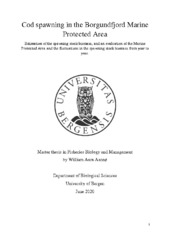Cod spawning in the Borgundfjord Marine Protected Area
Master thesis
Permanent lenke
https://hdl.handle.net/1956/23085Utgivelsesdato
2020-06-27Metadata
Vis full innførselSamlinger
Sammendrag
The Norwegian coastal cod population north of 62°N declined in the years from 1997 to 2005 and has since remained low. The Borgundfjord has since 2009 served as an extractive Marine Protected Area (MPA) for protecting the coastal cod, as it is an important spawning ground for this threatened population. This implies that the area is closed for commercial harvesting and net fishing during the spawning season lasting from 1 March to 31 May. Recreational angling is however permitted. The Institute of Marine Research has from 2012 to 2019, with an exception in 2014, performed weekly net hauls during the spawning season. In this study I have analysed the egg data from these hauls, with the aim of estimating the annual spawning stock biomass (SSB) in the area, and in that way evaluate if the introduction of the MPA has had any effect on the coastal cod population in Borgundfjord. The biomass was estimated to be around 200 – 400 tonnes, where the highest SSB was estimated for 2013 (⁓ 590 tonnes), but the 95 % confidence interval showed a great uncertainty. Year 2017 had the lowest estimated SSB at approximately 145 tonnes. I have investigated whether other factors than an actual change in SSB could have caused the fluctuations in the egg-based SSB estimates from year to year, including factors like sea currents, hydrography and condition of the female cod. None of these factors seem to explain the fluctuations in SSB. The results suggest that there neither has been an increase in the SSB nor a drop in the mortality as consequence of the MPA implementation. Because of this, it is argued that the MPA has not had the desired effect of protecting the coastal cod. This study describes a standardized way of estimating the spawning stock biomass of cod within a Marine Protected Area, using data from net hauls, egg genetics, hydrography and commercial cod landings. This standardized way could be applied to other MPAs where it is desired to estimate the SSB.
